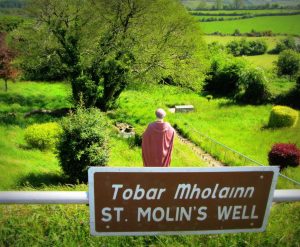In normal times we would be celebrating Mass at Saint Moling’s well this Sunday, 22nd August. The pattern is celebrated annually at the well, not on the feast of Saint Moling but on the feast of Saint Bernard, the 20th August, should it fall on a Sunday, or if not on the next Sunday following. The association of Saint Bernard with the well came from the influence of the monks of Jerpoint Abbey.
In ancient times people had a deep reverence for water and venerated their wells with wonder and gratitude. Water emerging from rocks on the mountain or from a spring in the field was looked upon as a small miracle. Water was God’s gift, celebrated in all ancient religions. Many of the sagas of ancient Ireland celebrated the holy well. The salmon of knowledge was flushed from the holy well of Segais into the Boyne.
Mere contact with the salmon gave a person supernatural power!
After the coming of Christianity, holy wells were no longer seen as having divine or miraculous powers of their own. Rather they were seen as a source of God’s grace where people could go and pray for healing.
After the reformation there was an upsurge in traditional devotions in Ireland. Holy wells and patterns became central to b eing a catholic. Stations of the Cross began to appear at holy wells. Priests began to celebrate mass at the wells, as well as giving sermons and leading people in prayer. What is interesting is that rich and poor alike attended these celebrations, and the presence of the priest ensured that there was no conflict between the traditional devotions and the teaching of the Church.
By the late eighteen hundreds, the holy wells had come to be regarded with suspicion by the authorities because of disorderly religious and non-religious practices associated with them. However, a new appreciation of Ireland’s Gaelic past gave them a new lease of life. The wells and the patterns came to be seen as expressions of a genuine Irish spirituality. In the nineteen hundreds, statues of Our Lady and of local saints were added at the site of the wells. In this way celebrations at holy wells included local devotions as well as the devotions of the universal Church. The statueof Saint Moling proudly overlooks the well dedicated to his honour in Mullinakill.
We sincerely thank the members of the Saint Moling’s well committee who care for the well, the shrine and the grounds at Mullinakill. Your work is very much appreciated.
